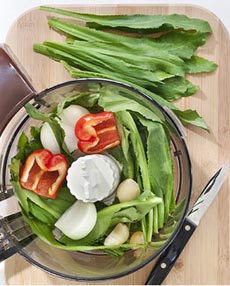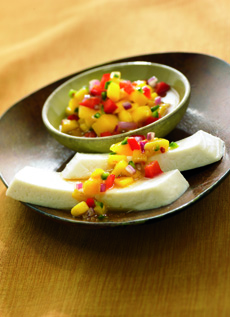
Making recaito: Simply blend culantro and other ingredients in a food processor. Photo courtesy BonniePlants.com. |
|
When we first saw the word “culantro,” we thought somebody had misspelled “cilantro.”
But we looked it up: Culantro is a cousin to cilantro. They’re members of the same botanical family, Apiaceae, commonly known as carrot or parsley family.*
Cilantro (Coriandrum sativum), which looks like flat leaf Italian parsley, and culantro (Eryngium foetidum), which has elongated leaves, have a similar (but not identical) flavor and aroma. Culantro is much stronger in flavor, and is used in smaller amounts.
Easy-to-grow culantro is native to Mexico/Central America and is cultivated worldwide. It first grew wild at the edge of forests, so grows well in partial shade.
Culantro can be used as you would use cilantro, and is an essential ingredient recaito, a Caribbean green salsa used to flavor numerous dishes.
|
*The Apiaceae family includes angelica, anise, arracacha, asafoetida, caraway, celery, chervil, cumin, dill, fennel, parsley…and some 3,700 other plants.
|
|
RECAITO & SOFRITO
In the Caribbean, culantro is commonly called recao, which gives its name to recaito, a popular green sauce/salsa used to flavor a variety of dishes. Recaito is an aromatic purée of culantro (recao), green cubanelle peppers (similar in flavor to to bell peppers but longer, with thinner flesh and lightly more wrinkled), onions, garlic and ajies dulces (small red bell peppers).
Recaito is used in bean and rice dishes, soups and stews, often added toward the end of cooking as a finishing touch to the recipe. Add a tablespoon of it to your next rice or bean dish; you’ll love the bright flavor.
Culantro is also the base of sofrito.
|
|

If you see a culantro plant for sale, grab it. Or grow your own from seeds. Photo by Maxintaft | Wikimedia. |
The difference between recaito and sofrito: Recaito is an uncooked green salsa; sofrito uses recaito as a base, sautéed with tomatoes. As with any recipe, there are regional differences (not to mention household diffrences). For example, Puerto Rican cooks typically don’t use tomatoes in their sofritos.
RECAITO RECIPE
Ingredients
If you can’t find all of the ingredients, substitute green and red bell peppers for the cubanelle and aji dulce peppers; and substitute cilantro for culantro.
2 medium green bell, seeds removed
2 medium onions, peeled
1 bulb of garlic, peeled
1 bunch culantro leaves, washed and patted dry
6 small red bell peppers
Preparation
Simply chop and blend the ingredients in a food processor or blender.
Culantro By Any Other Name
Culantro is known by many names. In addition to recao (Spanish), which gives its name to recaito, there are: false coriander, long coriander, bhandhanya (Hindi), langer koriander (German), ngo gai (Vietnamese), pak chi farang (Thai).
We know people who don’t like cilantro. There’s even a website, IHateCilantro.com, the opening line of which is, “Cilantro. The most offensive food known to man.”
Let’s hope those folks don’t discover culantro.
|
|










